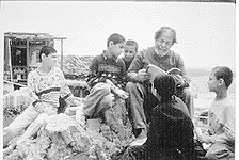Through the Olive Trees (Abbas Kiarostami, 1994)
 The third film in Iranian director Abbas Kiarostamiís
unofficial trilogy of films set in the rural region surrounding the town of
Koker, Through the Olive Trees extends
the themes present in the previous two films to the point of emotionally
numbing, if intellectually admirable, redundancy. A fictional film that
chronicles the shooting of one scene of Life
and Nothing More..., the previous work in the trilogy, Trees bites off considerably less than its predecessor, leaving it
with precious little to chew over. Self-reflexive to a fault, it begins with an
announcement from the lead actor that heíll be playing the director of the
ďfictionalĒ film, and immediately the question springs to mind as to why
Kiarostami doesnít play himself here. A straightforward documentary would be
the most logical way to illustrate the existence of truth behind the story that
he told, but he needlessly follows up one form of narrative subterfuge here with
another, pushing the audience away from the ďtruthĒ (which admittedly might
be unattainable anyway).
The third film in Iranian director Abbas Kiarostamiís
unofficial trilogy of films set in the rural region surrounding the town of
Koker, Through the Olive Trees extends
the themes present in the previous two films to the point of emotionally
numbing, if intellectually admirable, redundancy. A fictional film that
chronicles the shooting of one scene of Life
and Nothing More..., the previous work in the trilogy, Trees bites off considerably less than its predecessor, leaving it
with precious little to chew over. Self-reflexive to a fault, it begins with an
announcement from the lead actor that heíll be playing the director of the
ďfictionalĒ film, and immediately the question springs to mind as to why
Kiarostami doesnít play himself here. A straightforward documentary would be
the most logical way to illustrate the existence of truth behind the story that
he told, but he needlessly follows up one form of narrative subterfuge here with
another, pushing the audience away from the ďtruthĒ (which admittedly might
be unattainable anyway).
 Thereís nothing thatís fundamentally dishonest in
Kiarostamiís approach, but his lack of forthrightness still frustrates at
times. Though by all accounts Kiarostami is a modest, exemplary human being, the
scenes where he shows his surrogate hanging out with the local children and
talking to them about the virtues of cooperation, I found myself cringing. His
modesty is refreshing in contrast to the giant egos that seem to define so many
other major directors, but it feels misplaced and slightly patronizing. For
example, in one scene, his production assistant is driving to the set and is
delayed by a construction crew that is blocking the road she needs to take with
their equipment. A brief exchange occurs, and the implication is made that the
work of the carpenters is just as important as that of the filmmakers. While
that sentiment is somewhat noble, itís also horribly reductive and essentially
untrue. Itís hard to complain about a director who exhibits the sort of
sensitivity that Kiarostami does, but when there arenít fresh ideas
accompanying those sentiments, itís just as hard to accept his self-anointed
veneration.
Thereís nothing thatís fundamentally dishonest in
Kiarostamiís approach, but his lack of forthrightness still frustrates at
times. Though by all accounts Kiarostami is a modest, exemplary human being, the
scenes where he shows his surrogate hanging out with the local children and
talking to them about the virtues of cooperation, I found myself cringing. His
modesty is refreshing in contrast to the giant egos that seem to define so many
other major directors, but it feels misplaced and slightly patronizing. For
example, in one scene, his production assistant is driving to the set and is
delayed by a construction crew that is blocking the road she needs to take with
their equipment. A brief exchange occurs, and the implication is made that the
work of the carpenters is just as important as that of the filmmakers. While
that sentiment is somewhat noble, itís also horribly reductive and essentially
untrue. Itís hard to complain about a director who exhibits the sort of
sensitivity that Kiarostami does, but when there arenít fresh ideas
accompanying those sentiments, itís just as hard to accept his self-anointed
veneration.
 Like the simplistic first entry in the series, Where is
the Friend's Home?, this film suffers by association with Kiarostamiís Life
and Nothing More... (his best work, in my estimation).
Since that masterpiece had so much to say about the inadequacy of film to
capture the miraculous nature of life, this one's meditations on the same
subject matter pale in comparison. The central relationship, between two of the
actors in Life..., isnít exactly boring, but the filmís rapt
attention to it is disappointing since they were just bit players in the epic
landscape of the previous film. Worse still, the silent, coy mistress feels
like a literary conceit, and her presence undermines the impression that the
coupleís relationship is meant to reflect real life. The marriage proposal
story that Kiarostami created for LifeÖ
is more moving than the one here, though maybe thatís the point and a
testament to the directorís artistry (though if that is
his point, then I would object to his self-congratulatory message). In LifeÖ, Kiarostami crafted their story into a short, simple, hugely
uplifting parable about the way that life carries on in the face of death. Here,
he offers a boondoggle and expects the audience to cheer the comparative lack of
artistry. Nonetheless, the superb final shot, which does more to damn
Kiarostami's switch to digital than any critic could, almost makes the trek
worth it.
Like the simplistic first entry in the series, Where is
the Friend's Home?, this film suffers by association with Kiarostamiís Life
and Nothing More... (his best work, in my estimation).
Since that masterpiece had so much to say about the inadequacy of film to
capture the miraculous nature of life, this one's meditations on the same
subject matter pale in comparison. The central relationship, between two of the
actors in Life..., isnít exactly boring, but the filmís rapt
attention to it is disappointing since they were just bit players in the epic
landscape of the previous film. Worse still, the silent, coy mistress feels
like a literary conceit, and her presence undermines the impression that the
coupleís relationship is meant to reflect real life. The marriage proposal
story that Kiarostami created for LifeÖ
is more moving than the one here, though maybe thatís the point and a
testament to the directorís artistry (though if that is
his point, then I would object to his self-congratulatory message). In LifeÖ, Kiarostami crafted their story into a short, simple, hugely
uplifting parable about the way that life carries on in the face of death. Here,
he offers a boondoggle and expects the audience to cheer the comparative lack of
artistry. Nonetheless, the superb final shot, which does more to damn
Kiarostami's switch to digital than any critic could, almost makes the trek
worth it.
* * 1/2
01-14-03
Jeremy Heilman